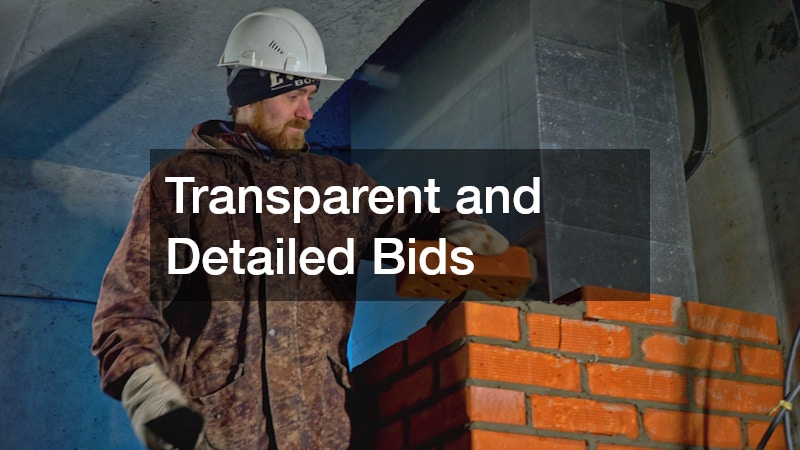
Embarking on a custom house remodel is exhilarating, but excitement alone will not keep the dust at bay, the budget intact, or the vision coherent. When you invite a remodeling crew into your life, you hand them the keys to both your biggest asset and your daily routines. That level of trust demands rigorous vetting. Savvy homeowners therefore look beyond glossy portfolios to deeper indicators of professionalism: transparent bids, disciplined scheduling, and a rock-solid network of vetted subcontractors. They also weigh communication style, job-site cleanliness, and how quickly the team resolves inevitable surprises once walls come down. A methodical selection process keeps stress in check and steers every decision back to long-term goals for lifestyle, sustainability, and resale value. The twelve traits outlined below will help you compare contenders with confidence and choose a partner who translates inspiration boards into craftsmanship you can live with for decades. Invest the time up front, and the payoff will echo through every finished room.
Proven Track Record and References
The first trait to verify is a contractor’s history of delivering projects on time and without budget-busting surprises. Ask for at least three recent clients whose homes required structural changes comparable to your own custom house remodel, and actually call them. Probe for specifics: did crews respect routines, keep walkways tidy, and address setbacks transparently? A firsthand walk-through lets you inspect trim lines, tile alignment, and paint transitions better than any photo gallery. Inquire about warranty callbacks; frequent fixes hint at lax quality control. Strong remodelers also coordinate trusted specialists—a residential roofing company, licensed electricians, and master carpenters—so every phase dovetails smoothly. Finally, scan the building department’s permit records; steady volume with few complaints proves solid management systems. Professionals who welcome this scrutiny and readily show insurance certificates, licenses, and active job sites are far likelier to honor timelines and protect your investment. Follow up by asking past clients whether the contractor finished punch-list items promptly, returned for seasonal inspections, and provided detailed manuals for new systems; these small gestures often distinguish elite builders from average crews.
Licensing, Insurance, and Certifications
Legitimate remodelers treat paperwork as seriously as craftsmanship. Begin by confirming that the firm carries general liability, workers-compensation, and, when applicable, builder’s risk insurance. These policies shield you from legal exposure if a subcontractor is injured or a neighbor’s property is damaged during demolition. Next, verify state contractor licenses and any specialty endorsements, such as asbestos abatement or historic-structure work. Credentials demonstrate that management invests in continuing education and adheres to evolving codes—qualities you absolutely need when an HVAC company upgrades ductwork the same week a concrete contractor service pours new footings. Ask which professional associations the business belongs to and whether field supervisors hold OSHA safety certifications. Bonding status is another layer of protection, providing financial recourse if the company fails to complete the project. A qualified remodeler will furnish digital copies of all documents without hesitation and will even add you as an insured party for the project’s duration. Remember, the cost of one uninsured accident can dwarf every savings promised by the cheapest bid.
Transparent and Detailed Bids
Clear pricing either builds trust or breeds doubt. A reputable firm will break its estimate into line items for labor, materials, permits, and contingencies rather than hiding totals in vague allowances. As you parse the bid for your custom house remodel, look for brand-name specifications: framing lumber grades, window performance ratings, and model numbers for appliances like tankless hot water heaters. These specifics allow apples-to-apples comparisons across competing proposals and prevent cheap substitutions once work begins. Ask the estimator to flag items prone to price swings—lumber, copper, and fuel—and to spell out how change orders are handled if structural surprises surface. The written scope should also clarify what is excluded, such as landscape repairs after trenching or furniture storage during refinishing. When cost categories are transparent, you can slice or upgrade components strategically without scrambling the entire budget. A detailed bid signals respect for your money and establishes a paper trail that helps resolve disputes should expectations drift during construction. Never accept a lump-sum figure on a napkin; insist on a formal document with contractual weight both parties sign before the first nail is pulled.
Project Management and Scheduling Expertise
Even the most inspired design will sputter without disciplined coordination. Top remodelers map every task—demolition, framing, inspections, and finishes—onto a critical-path schedule that exposes interdependencies and cushions for weather delays. Ask to see a sample Gantt chart from a previous job of similar scope. A well-maintained schedule lists start and end dates for each trade, material lead times, and inspection milestones that could stall progress if paperwork is late. Inquire how the firm manages tasks needing outside regulators, such as health-department approvals for septic pumping when adding bathrooms or expanding over aged drain fields. Equally important is communication: will you receive weekly emails, app notifications, or in-person walk-throughs? Real-time transparency lets you book time off work to review electrical layouts or mock-up cabinet heights. Finally, verify who owns the timeline—lead carpenter or dedicated coordinator—and whether updates are logged daily so slippage is corrected before it snowballs. The best schedulers also monitor supply-chain forecasts; if a supplier flags a delay on specialty tile, the manager reorders from an alternate warehouse before crews stand idle, saving you both days and dollars.
Communication Culture and Client Portal Use
A successful custom house remodel depends as much on information flow as on carpentry. You will be making hundreds of micro-decisions, from grout colors to pendant-light heights, and those choices need a structured pipeline. Ask prospective builders whether they use a cloud-based client portal that stores drawings, daily logs, and progress photos. With a few taps on your phone you should see which rooms are ready for paint and which still await rough plumbing. Timely updates also illuminate hidden tasks a homeowner can forget, such as scheduling a preventive drain cleaning service before new fixtures are connected or clearing garage space for appliance deliveries. A culture of proactive communication reduces change orders because questions are answered while options are still inexpensive. During interviews, note how quickly the office returns calls and whether emails include clear next steps. A contractor who is vague during courtship is unlikely to grow suddenly precise once the contract is signed. Choose a team that treats your inbox as seriously as your joist spans, and decision fatigue will recede instead of crescendo.
Skilled Specialized Trade Network
Your remodeler’s rolodex is almost as important as the skills of their in-house crew. Projects demand experts in everything from framing to fine plaster, and the general contractor must choreograph them with ballet-level timing. Ask which landscape company they partner with to grade yards and re-route irrigation lines; disturbed soil from construction can otherwise cause drainage nightmares. If the driveway needs widening to accommodate construction dumpsters or new garage bays, confirm the asphalt paving service they rely on can mobilize when specified, not months later. Similarly, determine whether millwork comes from a dedicated shop or a rotating cast of lowest-bid providers; consistency yields tighter tolerances. A builder who maintains long-term relationships can secure better pricing and priority scheduling during peak season. These alliances also reveal how the company resolves conflict: subcontractors rarely stay loyal to firms that dodge invoices or ignore safety protocols. When you hire for a custom house remodel, you are hiring an entire ecosystem, so vet the ecosystem, not merely the project manager. Ask to meet key subcontractors during the bidding phase; their professionalism and enthusiasm mirror the standards the general contractor upholds. This will ensure your custom house remodel goes off without a hitch.
Safety Standards and Site Cleanliness
Construction zones are inherently messy, but they should never be hazardous. Ask each bidder for a written safety plan detailing PPE requirements, fall-protection protocols, and daily housekeeping routines. Look for evidence that supervisors conduct toolbox talks and document near-miss incidents; this culture of accountability trickles down to the smallest details, like capping exposed rebar and taping down extension cords. Job-site cleanliness protects more than human bodies—it shields HVAC returns from drywall dust that could clog filters and compromise indoor air quality. Regular debris removal also discourages pests; an experienced local exterminator will confirm that food scraps and damp lumber piles invite rodents long before the final punch list. Professional remodelers schedule dump-trailers at predictable intervals so refuse never towers above window sills, and they deploy negative-pressure barriers to keep particles from infiltrating lived-in areas. When a team respects safety and cleanliness, delays drop, change-order rates shrink, and your living environment stays healthy throughout the renovation journey. Insist on photographic evidence of daily cleanup; documenting housekeeping tasks motivates crews to finish and signals that management values your family’s well-being as much as the final aesthetic.
Sustainability and Energy Efficiency Focus
Homeowners increasingly weigh environmental impact alongside aesthetics when planning a custom house remodel, and the best contractors respond with data rather than buzzwords. Inquire about their experience achieving above-code insulation values, integrating solar-ready conduit, or specifying low-VOC finishes that protect indoor air quality. Ask whether they perform blower-door tests before drywall to pinpoint leaks and adjust air-sealing strategies. A contractor genuinely committed to efficiency will maintain relationships with energy raters and supply houses that stock recycled-content drywall, FSC-certified lumber, and advanced framing hardware. Discuss lifecycle costs too: a cheaper window with a poor U-factor may eat the savings through higher utility bills within a few winters. Top firms also design mechanical systems and building envelopes in tandem, preventing oversized equipment and condensation issues. When sustainability is treated as a core metric, not an afterthought, you gain lower operating costs, healthier interiors, and higher resale value—proof that stewardship and long-term financial sense often align. Finally, request documentation of past utility-bill reductions; empirical results speak louder than marketing slogans and give you tangible benchmarks.
Warranty and Post-Project Support
The exhilaration of a ribbon-cutting fades fast if cabinet doors sag or a faucet leaks six months later. An elite contractor backs every custom house remodel with a comprehensive warranty that covers workmanship and major systems far beyond the statutory minimum. Seek clarity on duration: structural components may carry a ten-year guarantee, while paint touch-ups might last two. Find out how warranty requests are logged—an online ticket system beats voicemail roulette—and whether you will receive a homeowner manual that lists paint colors, appliance serial numbers, and filter-change schedules. Also ask how seasonal maintenance is handled. Some firms offer annual check-ups in which technicians flush tankless hot water heaters, adjust door hardware, and reseal grout to preserve finishes. Verify that subcontractors honor manufacturer warranties and that the general contractor remains your single point of contact, eliminating finger-pointing if something fails. When robust after-care is routine, you can relax knowing the team that built your home stands ready to protect it, transforming a transaction into a long-term partnership. This commitment signals financial stability, because only companies confident they will be around in five years dare promise service.
Financial Stability and Payment Terms
Money is the oxygen of any construction site, and cash-flow hiccups can choke a project midstream. Request bank or supplier letters that confirm the builder has credit lines sufficient to front materials before your draws are released. A steady balance sheet matters even more on a custom house remodel that involves high-ticket milestones like engineered trusses or basement construction requiring deep excavation and waterproofing. Discuss payment schedules linked to verifiable milestones rather than arbitrary dates; for example, a check when rough-in inspections pass, not simply two weeks after framing starts. Insist on lien releases with each installment so subcontractors cannot file claims against your property later. Also, explore retention clauses—holding back a small percentage until final punch-list items are complete—which incentivizes swift wrap-up. A financially disciplined contractor will welcome this framework, viewing it as proof that both parties value transparency and accountability. Any hesitation or request for large upfront deposits should raise alarms; solvent firms do not need your money to fund yesterday’s unfinished job. Finally, clarify how change-order costs are invoiced; reputable builders charge the actual incremental expense, not an inflated flat percentage.
Hiring for a custom house remodel is less about choosing the lowest bid and more about selecting a long-term ally. Contractors who display the twelve traits above—documented track records, airtight paperwork, transparent pricing, disciplined schedules, responsive communication, trustworthy trade partners, rigorous safety habits, sustainability savvy, robust warranties, solid finances, genuine empathy, and local code fluency—will protect your budget and your sanity. Take time to verify each quality before signing: call references, read sample contracts, tour active sites, and quiz project managers on their processes. Yes, the homework is tedious, but it pales next to the chaos of missed inspections, ballooning change orders, or unfinished punch lists. By filtering contenders through these benchmarks, you secure a builder who turns design dreams into durable reality and stands ready to serve long after the last drop of paint dries. The reward is a home that fits like a glove, enriches daily routines, and appreciates in value.








